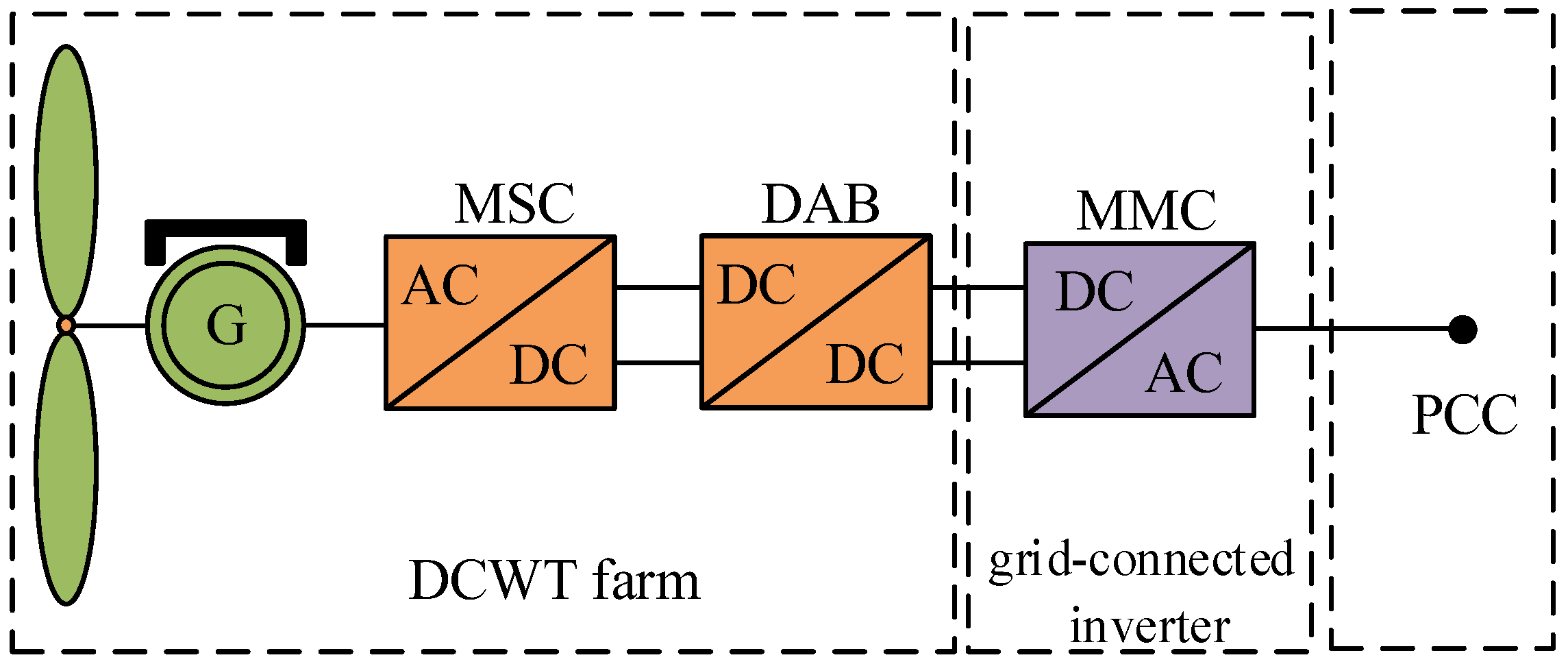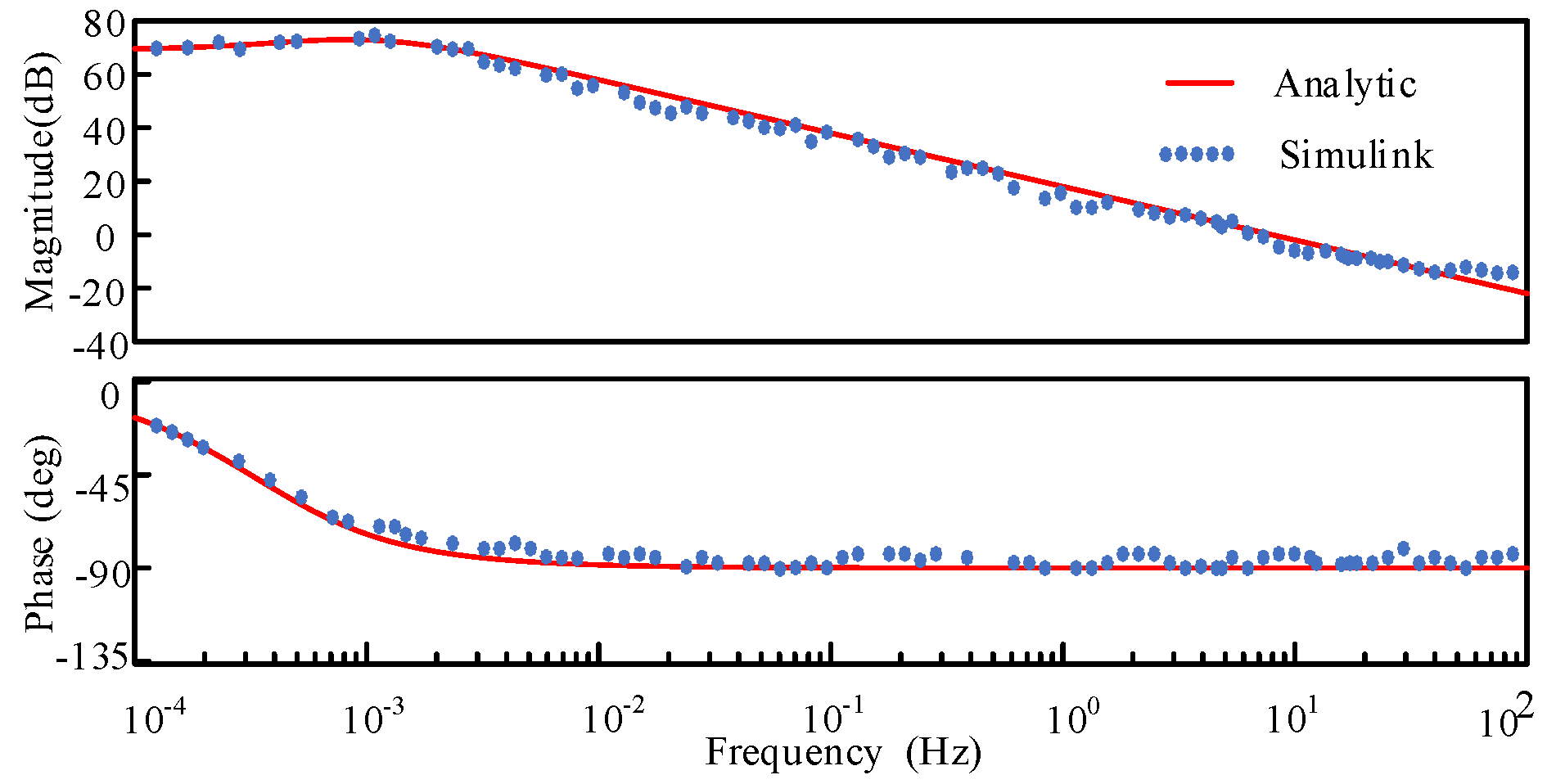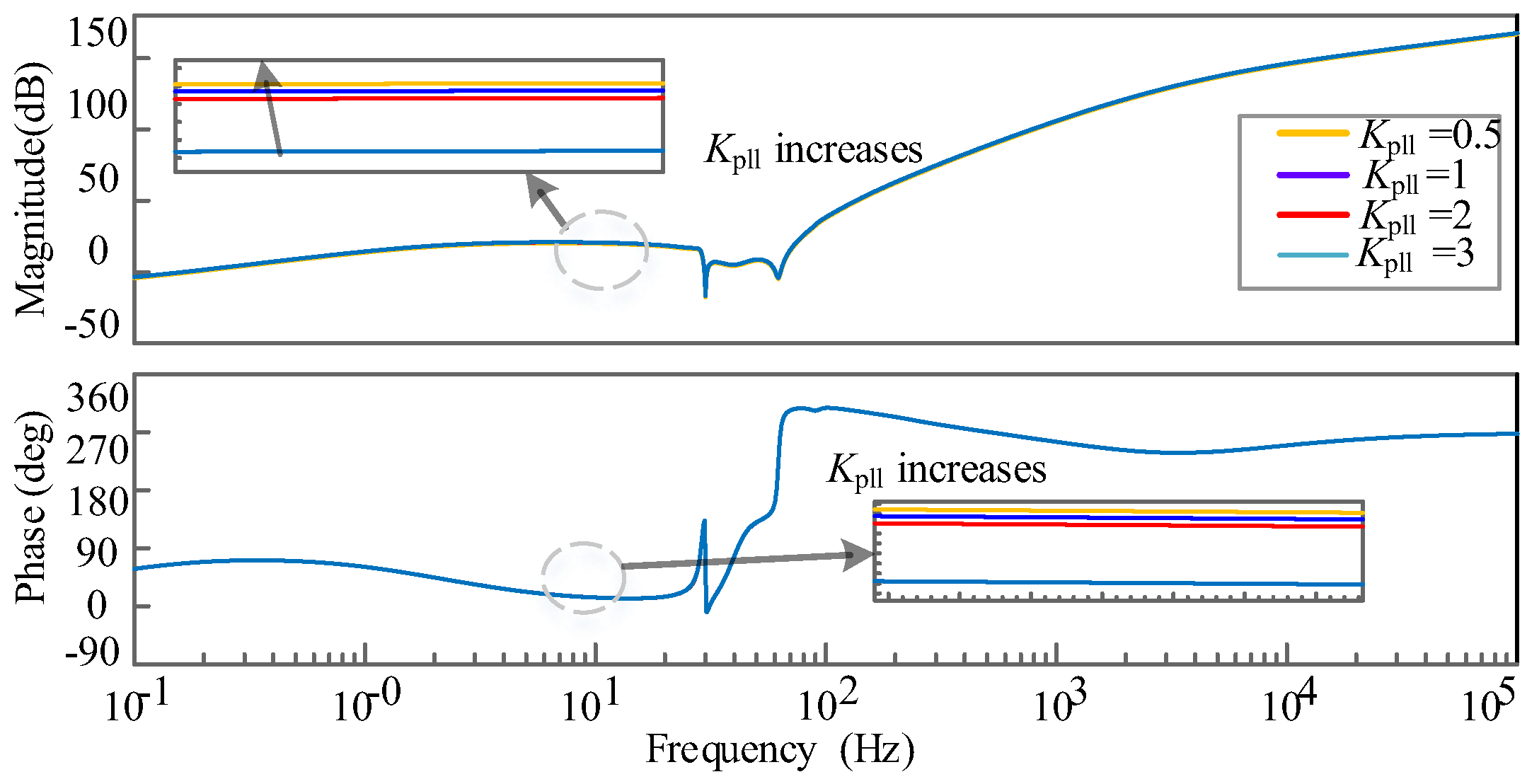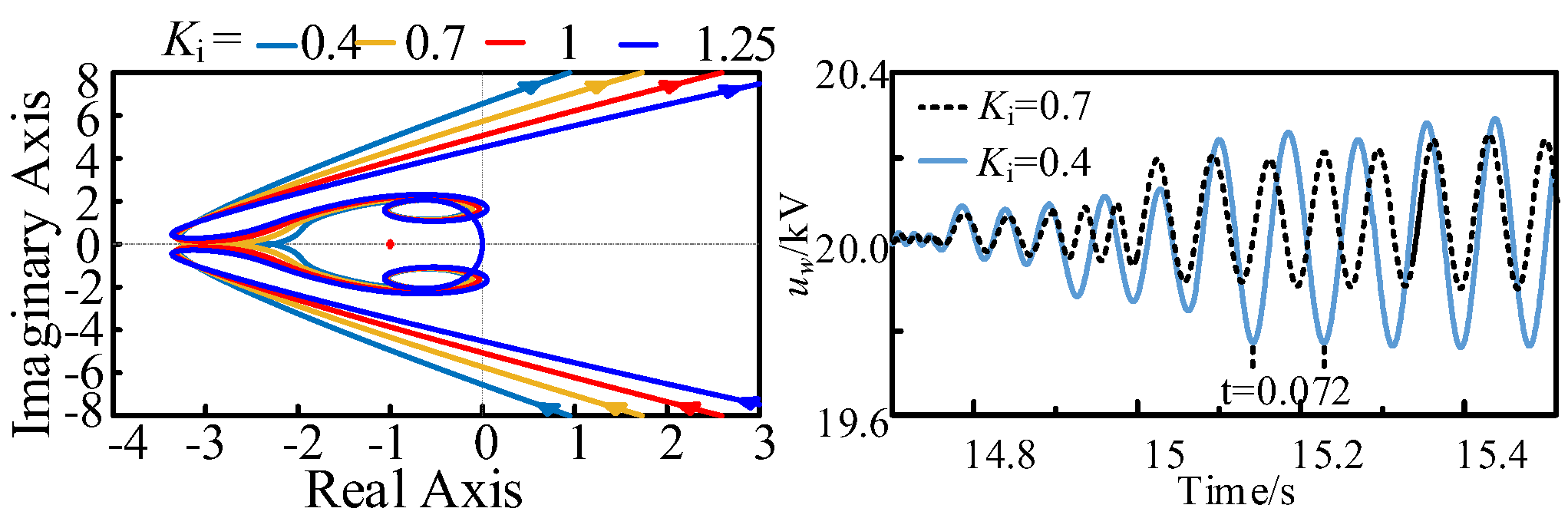Small Disturbance Stability Analysis of Onshore Wind Power All-DC Power Generation System Based on Impedance Method
Abstract
:1. Introduction
- (1)
- It introduces a novel topology for the OWDCG, detailing the critical modules and control strategies associated with this new topology.
- (2)
- It presents a methodology for the stability analysis of OWDCG systems under small disturbances and identifies the key parameters influencing system stability.
2. Materials and Methods
2.1. System Topology and Control Strategy
2.1.1. System Topology
2.1.2. Key Module Topology and Control Strategy
2.2. Impedance Model
2.2.1. Source-Side Subsystem Output Impedance Model
2.2.2. Network-Side Subsystem Input Impedance Model
2.2.3. Model Validation
2.3. Impedance Characterization
2.3.1. Effect of Circuit Parameters on Subsystem Impedance Characteristics
2.3.2. Effect of Control Parameters on System Impedance Characteristics
3. Results
4. Discussion
- (1)
- In response to the pronounced mismatch between the source and the network following the integration of large-scale wind power access systems, this study proposes an effective solution for organizing large-scale wind power aggregation and transmission grids. This approach is specifically designed for implementation in the resource-rich regions with developed onshore wind energy in northwestern China. Its primary goal is to fortify the interconnection between the power source and the network, thus improving the operational stability of the power grid. By capitalizing on the inherent benefits of traditional AC aggregation and transmission, combined with AC aggregation and DC transmission within a unified DC network framework, this strategy significantly reduces the need for rectifier inverters, thereby decreasing power losses. Moreover, employing DC transmission across various frequency domain station areas for interconnection leads to a lower short-circuit capacity. Consequently, this method provides an effective solution to overcome challenges related to AC aggregation, such as issues with reactive power transmission and harmonic resonance.
- (2)
- Leveraging the impedance framework of the OWDCG system, this study aims to identify the primary factors leading to oscillatory instability under small disturbances, with a particular focus on the dynamics involving multi-inverter control coupling. To achieve this, a comprehensive analysis is conducted, encompassing impedance characterization and the identification of dominant parameters. The findings offer a theoretical foundation for improving the stability of the OWDCG in response to minor perturbations. Unlike the stability factor analysis related to conventional wind turbine AC convergence and transmission under small disturbances, this research underscores that the Modular Multilevel Converter (MMC) control parameters within the OWDCG architecture play a crucial role in influencing its oscillatory behavior.
- (3)
- The stability analysis of small perturbations in the OWDCG system and the identification of dominant factors discussed in this paper hold significant relevance for the design and optimization of controllers in practical engineering applications of fully integrated DC wind power generation systems. This analysis plays a pivotal role in ensuring the system’s safe and stable operation. It is important to note that this paper does not account for the impacts of more complex topologies and varied control strategies. Leveraging the findings from this study, future research could further investigate stability across multiple topologies and control strategies to pinpoint the dominant factors affecting system stability. Moreover, future studies might also examine the system’s stability characteristics across different power regions, thereby expanding our understanding of its operational dynamics.
5. Conclusions
- (1)
- Increasing the DCWT outlet capacitance Cf and DAB control gain K4 is detrimental to the system small disturbance stabilization, and increasing the MMC inverter DC voltage control loop gain Ku and current inner-loop gain Ki is beneficial to the system stabilization. Increasing the MSC controller gains K1–K3, DC transmission line resistance Rline, inductance Lline, loop current control gain Kcir, and phase-locked loop control gain Kpll have less effect on the system’s small disturbance stabilization.
- (2)
- The degree of influence of different parameters on the impedance characteristics of subsystems and the small disturbance stability of the system is revealed; Ku and Ki are the dominant factors of the small disturbance stability, and Ku has the greatest influence on the optimal design of the system control parameters to provide a theoretical basis for the stable operation of the onshore wind power all-direct current power generation system, which has a guiding significance in engineering.
Author Contributions
Funding
Data Availability Statement
Acknowledgments
Conflicts of Interest
Appendix A
Appendix B

Appendix C
| Module | Parameters | Value |
|---|---|---|
| Wind power turbine | Wind power turbine radius R/m | 58 |
| Air density p/kg·m−3 | 1.225 | |
| Self-damping factor Rm | 0.002 | |
| D-PMSG | Polar logarithm np | 49 |
| Stator equivalent resistor Rs/Ω | 0.001 | |
| Stator equivalent inductance Ls/mH | 12.8 | |
| Rotor magnetic chain Ψf/Wb | 0.0417 | |
| DC side | MSC outlet capacitance Cg/mF | 12 |
| MSC control system | Rotation speed reference Rref/p.u. | 0.8 |
| Stator current d-axis reference isdref | 0 | |
| Rotation speed outer-loop factor (kp2, ki2) | 0.4, 0.4 | |
| q-axis current inner-loop factor (kp3, ki3) | 1, 0.2 | |
| d-axis current inner-loop factor (kp1, ki1) | 1, 0.2 | |
| MSDCT control system | Voltage outer-loop factor (kp4, ki4) | 0.1, 0.075 |
| DCWT outlet | DCWT outlet capacitance Cf/mF | 20 |
| Module | Parameters | Value |
|---|---|---|
| Inverter | Submodule number | 20 |
| Bridge resistance Rarm/Ω | 0 | |
| Bridge inductance Larm/mH | 20 | |
| Bridge capacitance Carm/mF | 15 | |
| Voltage control system | DCWT outlet voltage reference uwref/p.u. | 1 |
| q-axis current inner-loop reference iqref/p.u. | 0 | |
| Voltage outer-loop factor (kpu, kiu) | 0.5, 3 | |
| Current inner-loop factor (kpi, kii) | 30, 300 | |
| Circulation suppress control | q-axis circulation inner-loop reference | 0 |
| d-axis circulation inner-loop reference | 0 | |
| q-axis circulation inner-loop factor (kpcir, kicir) | 1, 2400 | |
| d-axis circulation inner-loop factor (kpcir, kicir) | 1, 2400 | |
| Phase-locked loop control | Phase-locked loop factor (kpllp, kplli) | 0.1, 100 |
References
- Jiang, L.; Chi, Y.; Qin, H.; Pei, Z.; Li, Q.; Liu, M.; Bai, J.; Wang, W.; Feng, S.; Kong, W.; et al. Wind Energy in China. IEEE Power Energy Mag. 2011, 9, 36–46. [Google Scholar] [CrossRef]
- An, F.; Zhao, B.; Cui, B.; Bai, R. Multi-functional DC collector for future ALL-DC offshore wind power system: Concept, scheme, and implement. IEEE Trans. Ind. Electron. 2022, 69, 8134–8145. [Google Scholar] [CrossRef]
- Liu, W.; Ge, R.; Li, H.; Ge, J. Impact of Large-Scale Wind Power Integration on Small Signal Stability Based on Stability Region Boundary. Sustainability 2014, 6, 7921–7944. [Google Scholar] [CrossRef]
- Liu, H.; Xie, X.; Li, Y.; Liu, H.; Hu, Y. A small-signal impedance method for analyzing the SSR of series-compensated DFIG-based wind farms. In Proceedings of the 2015 IEEE Power & Energy Society General Meeting, Denver, CO, USA, 26–30 July 2015; pp. 1–5. [Google Scholar] [CrossRef]
- Salehi, F.; Matsuo, I.B.M.; Brahman, A.; Tabrizi, M.A.; Lee, W.J. Sub-Synchronous Control Interaction Detection: A Real-Time Application. IEEE Trans. Power Deliv. 2020, 35, 106–116. [Google Scholar] [CrossRef]
- Adams, J.; Carter, C.; Huang, S.-H. ERCOT experience with Sub-synchronous Control Interaction and proposed remediation. In Proceedings of the PES T&D 2012, Orlando, FL, USA, 7–10 May 2012; pp. 1–5. [Google Scholar] [CrossRef]
- Song, Y.; Blaabjerg, F. Analysis of the Behavior of Undamped and Unstable High-Frequency Resonance in a DFIG System. IEEE Trans. Power Electron. 2017, 32, 9105–9116. [Google Scholar] [CrossRef]
- Song, Y.; Wang, X.; Blaabjerg, F. Impedance-Based High-Frequency Resonance Analysis of DFIG System in Weak Grids. IEEE Trans. Power Electron. 2017, 32, 3536–3548. [Google Scholar] [CrossRef]
- Song, Y.; Blaabjerg, F. Overview of DFIG-Based Wind Power System Resonances Under Weak Networks. IEEE Trans. Power Electron. 2017, 32, 4370–4394. [Google Scholar] [CrossRef]
- Xu, Y.; Nian, H.; Hu, B.; Sun, D. Impedance Modeling and Stability Analysis of VSG Controlled Type-IV Wind Turbine System. IEEE Trans. Energy Convers. 2021, 36, 3438–3448. [Google Scholar] [CrossRef]
- Dong, W.; Du, W.; Xie, X.; Wang, H.F. An Approximate Aggregated Impedance Model of a Grid-Connected Wind Farm for the Study of Small-Signal Stability. IEEE Trans. Power Syst. 2022, 37, 3847–3861. [Google Scholar] [CrossRef]
- Li, M.; Zhang, X.; Guo, Z.; Wang, J.; Wang, Y.; Lib, F.; Zhao, W. The Control Strategy for the Grid-Connected Inverter Through Impedance Reshaping in q-Axis and its Stability Analysis Under a Weak Grid. IEEE J. Emerg. Sel. Top. Power Electron. 2021, 9, 3229–3242. [Google Scholar] [CrossRef]
- Nian, H.; Hu, B.; Xu, Y.; Wu, C.; Chen, L.; Blaabjerg, F. Analysis and Reshaping on Impedance Characteristic of DFIG System based on Symmetrical PLL. IEEE Trans. Power Electron. 2020, 35, 11720–11730. [Google Scholar] [CrossRef]
- Liu, J.; Yao, W.; Wen, J.; Fang, J.; Jiang, L.; He, H.; Cheng, S. Impact of Power Grid Strength and PLL Parameters on Stability of Grid-Connected DFIG Wind Farm. IEEE Trans. Sustain. Energy 2020, 11, 545–557. [Google Scholar] [CrossRef]
- Ma, R.; Han, Y.; Pan, W. Variable-Gain Super-Twisting Sliding Mode Damping Control of Series-Compensated DFIG-Based Wind Power System for SSCI Mitigation. Energies 2021, 14, 382. [Google Scholar] [CrossRef]
- Wu, H.; Wang, X. Passivity-Based Dual-Loop Vector Voltage and Current Control for Grid-Forming VSCs. IEEE Trans. Power Electron. 2021, 36, 8647–8652. [Google Scholar] [CrossRef]
- Ji, K.; Pang, H.; Liu, S.; Tang, G. Impedance Analysis Considering Unstable Subsystem Poles for MMC-HVDC-based Wind Farm Integration System. CSEE J. Power Energy Syst. 2022, 8, 634–639. [Google Scholar] [CrossRef]
- Ji, K.; Tang, G.; Pang, H.; Yang, J. Impedance Modeling and Analysis of MMC-HVDC for Offshore Wind Farm Integration. IEEE Trans. Power Deliv. 2020, 35, 1488–1501. [Google Scholar] [CrossRef]
- Wen, B.; Boroyevich, D.; Burgos, R.; Mattavelli, P.; Shen, Z. Analysis of D-Q Small-Signal Impedance of Grid-Tied Inverters. IEEE Trans. Power Electron. 2016, 31, 675–687. [Google Scholar] [CrossRef]
- Wang, C.; Pan, D.; Wang, X.; He, Y.; Zhang, H.; Ruan, X.; Chen, X. A General Graphical Method for Filter-Based Active Damping: Evaluation, Exploration, and Design. IEEE J. Emerg. Sel. Top. Power Electron. 2023, 11, 2683–2696. [Google Scholar] [CrossRef]
- Lin, Z.; Ruan, X.; Zhang, H.; Wu, L. A Generalized Real-Time Computation Method with Dual-Sampling Mode to Eliminate the Computation Delay in Digitally Controlled Inverters. IEEE Trans. Power Electron. 2022, 37, 5186–5195. [Google Scholar] [CrossRef]
- Hans, F.; Schumacher, W.; Chou, S.-F.; Wang, X. Passivation of Current-Controlled Grid-Connected VSCs Using Passivity Indices. IEEE Trans. Ind. Electron. 2019, 66, 8971–8980. [Google Scholar] [CrossRef]
- Ma, H.T.; Brogan, P.B.; Jensen, K.H.; Nelson, R.J. Sub-Synchronous Control Interaction studies between full-converter wind turbines and series-compensated AC transmission lines. In Proceedings of the 2012 IEEE Power and Energy Society General Meeting, San Diego, CA, USA, 22–26 July 2012; pp. 1–5. [Google Scholar] [CrossRef]
- Mohammadpour, H.A.; Islam, M.M.; Coats, D.; Santi, E.; Shin, Y.-J. Sub-synchronous resonance mitigation in wind farms using a gate-controlled series capacitor. In Proceedings of the 2013 4th IEEE International Symposium on Power Electronics for Distributed Generation Systems (PEDG), Rogers, AR, USA, 8–11 July 2013; pp. 1–6. [Google Scholar] [CrossRef]
- Lyu, J.; Cai, X.; Molinas, M. Optimal Design of Controller Parameters for Improving the Stability of MMC-HVDC for Wind Farm Integration. IEEE J. Emerg. Sel. Top. Power Electron. 2018, 6, 40–53. [Google Scholar] [CrossRef]






















Disclaimer/Publisher’s Note: The statements, opinions and data contained in all publications are solely those of the individual author(s) and contributor(s) and not of MDPI and/or the editor(s). MDPI and/or the editor(s) disclaim responsibility for any injury to people or property resulting from any ideas, methods, instructions or products referred to in the content. |
© 2024 by the authors. Licensee MDPI, Basel, Switzerland. This article is an open access article distributed under the terms and conditions of the Creative Commons Attribution (CC BY) license (https://creativecommons.org/licenses/by/4.0/).
Share and Cite
Wang, T.; Li, F.; Yin, C.; Jin, G. Small Disturbance Stability Analysis of Onshore Wind Power All-DC Power Generation System Based on Impedance Method. Energies 2024, 17, 1459. https://doi.org/10.3390/en17061459
Wang T, Li F, Yin C, Jin G. Small Disturbance Stability Analysis of Onshore Wind Power All-DC Power Generation System Based on Impedance Method. Energies. 2024; 17(6):1459. https://doi.org/10.3390/en17061459
Chicago/Turabian StyleWang, Tao, Fengting Li, Chunya Yin, and Guixin Jin. 2024. "Small Disturbance Stability Analysis of Onshore Wind Power All-DC Power Generation System Based on Impedance Method" Energies 17, no. 6: 1459. https://doi.org/10.3390/en17061459
APA StyleWang, T., Li, F., Yin, C., & Jin, G. (2024). Small Disturbance Stability Analysis of Onshore Wind Power All-DC Power Generation System Based on Impedance Method. Energies, 17(6), 1459. https://doi.org/10.3390/en17061459





